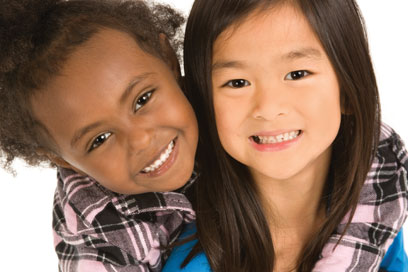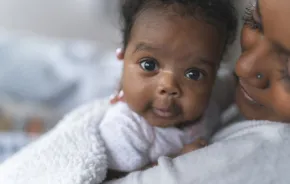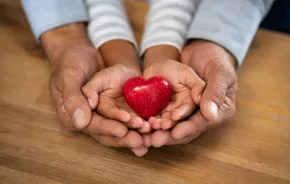 When Portland, OR. resident Mishelle Rudzinski adopted her 5-year-old daughter, Bakha, from Kazakhstan in 2006, she was prepared for life with a special needs child: The child had been diagnosed with cerebral palsy and muscular dystrophy.
When Portland, OR. resident Mishelle Rudzinski adopted her 5-year-old daughter, Bakha, from Kazakhstan in 2006, she was prepared for life with a special needs child: The child had been diagnosed with cerebral palsy and muscular dystrophy.
Bakha didn’t walk at all until she was 4, and then did so with her back hunched over. Yet within eight weeks of coming home, Bahka walked and ran on her own.
“It turns out she was malnourished, nothing else — and only had a case of rickets,” Rudzinski recalls. With rickets, a lack of vitamin D, phosphate or calcium can lead to weakening of the bones.
The problem stemmed from improper nutrition at the orphanage where she was raised. Once put on a healthy diet, Bakha improved.
Yet, she was not out of the woods.
“Sometimes parents will assume that their newly adopted kids are healthy because they have a little bit of weight on them. Often, those kids are most at risk,” says Rudzinski. “Their stores of iron and other nutrients are depleted. They are pulling from these depleted stores because they are growing so rapidly.”
If Bakha had been immediately put on the same diet as other children her age, she would have eventually outstripped her body’s stores of vital nutrients, including iron. As Rudzinski points out, her daughter wasn’t anemic when she arrived in the U.S., but her iron stores were low enough that she could have become so if she’d had a growth spurt.
These problems are not limited to children from overseas, Rudzinski says. They are as common in foster children in the U.S. as they are in kids born in the other popular countries from which people adopt: China, Ethiopia, Russia, South Korea and the Ukraine.
Although new parents may not realize it, many newly adopted children may not be as healthy as they look.
Rudzinski ought to know. She and Cindy Kaplan, another Portland woman who adopted an undernourished child from Kazakhstan, were inspired to co-found the Portland, OR-based Spoon Foundation after learning about post-adoption nutrition and the difference it can make. The organization works to improve the health of international adoptees and foster children through education, training, advocacy and research.
Nurturing healthy growth
One of the best ways to get your child’s new life off to a good start is to consult an international adoption physician before your adoption agency matches you with a child, Rudzinski says.
Since many countries provide at least some medical information about a potential adoptee, doctors at services like The Center for Adoption Medicine at the University of Washington Medical Center can tell you what to expect and provide further advice when you’re meeting the child and getting ready to take her home.
Seeing a doctor who specializes in international adoption after your return also makes sense, she says, because many pediatricians don’t have experience in dealing with medical issues that could arise even months after you’ve brought your child home. As Rudzinski points out, most doctors don’t know what the typical development and growth patterns of orphans are, or that diarrhea is a symptom of zinc deficiency.
HunterAnn Booth’s experience is a good example.
When the Lynnwood woman adopted 15-month old Alexei from Vladvivostok, Russia, he was so small and anemic that he left the orphanage in a 9 month-old’s clothing. Once he went from meals of watered-down porridge or broth and a little hot tea to baby food in a jar, everything changed.
“The incredible amount of growth he has had in a short time period is a huge amount of progress. He was growing so fast there was no way for us to catch up with iron,” she says. Two years later, Booth is still working with doctors Julian Davies and Julia Bledsoe at the UW to get Alexei to average height, weight and head circumference, using daily supplements of liquid iron.
Iron is just one of the nutrient deficiencies found in adopted children, according to adoptionnutrition.org, a website that’s the result of a collaboration between the Spoon Foundation and the Joint Council on International Children’s Services. Other deficiencies include folate, iodine, selenium and zinc.
The deficits are caused by a variety of factors, including inadequate prenatal care, not being breast fed, not getting formula and an inadequate diet. Although most adoptees catch up with their age group and develop normally, there may be some long-term effects on these children, including poor growth and learning problems, Rudzinski says.
The site suggests running a series of lab tests during the initial post adoption visit and again six months later, to help determine if your child is at risk for any of the conditions stemming from nutritional deficits.
While it’s essential the children, once home, get their required nutrients, Rudzinski suggests parents relax a bit when it comes to their kids’ food choices. Otherwise, the kids could end up with stress-related eating issues, such as hoarding, eating excessively or not eating at all, she says.
So if they go for the extra juice or extra ice cream or just extra anything, let them. “These kids are transitioning to a new diet,” she says. “It might not start off as being the healthiest diet, but as parents we have to let go of our idea of what the best diet is.”
David Volk is a stay-at-home dad to two toddlers and a freelance writer who specializes in writing about parenting, travel, food and business. He’s also the author of The Cheap Bastard’s Guide to Seattle and the blog cheapbastardseattle.com.











